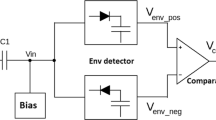Abstract
This paper proposes a low power wake-up baseband circuit used in Chinese Electronic Toll Collection (ETC) system. To reduce the static power consumption, a low power biasing strategy is proposed. The proposed circuit is fabricated in TSMC 0.18 μm technology with an area of 0.09 mm2. Its current consumption is only 2.1 μA under 1.8 V power supply. It achieves a sensitivity of 0.95 mV at room temperature with a variation of only ±28% over −35°C to 105°C.
Similar content being viewed by others
References
Kwon Kuduck, Choi Jae-Young Young, Choi Jeong-Ki, et al.. A 5.8 GHz integrated CMOS dedicated short range communication transceiver for the Korea/Japan electronic toll collection system. IEEE Transacions on Microwave Theory and Techniques, 58(2010)11, 2751–2763.
T. Masuda, Ken-ichi Ohhata, N. Shiramizu, et al.. Single-chip 5.8 GHz ETC transceiver IC with PLL and demodulation circuits using SiGe HBT/CMOS. IEEE International Solid-State Circuits Conference (ISSCC), San Francisco, CA, USA, February 7–11, 2002, 74–406.
T. Weise, J. Maag, G. Zimmermann, et al.. National overview of the German ETC program. IEEE Transactions on Magnetics, 39(2003)1, 35–38.
Jae-Won Won Jung, Seong-Ho Ho Kim, Kyung-Seung Seung Yang, et al. Overview of ETC research in Korea. IEEE Transactions on Magnetics, 39(2003)1, 22–23.
GB/T 20851-2007. Chinese DSRC Standard for ETC. 2007.
L. Bin and L. Peng. Budget analysis of RF transceiver used in 5.8 GHz RFID reader based on the ETC-DSRC national specifications of China. The 5th International Conference on Wireless Communications, Networking and Mobile Computing (WiCOM), Beijing, China, September 24–26, 2009, 1–3.
Hewlett Packard Corporation. HSMS2850, Suface Mount Microwave Schottky Detector Diodes. 1998, 1–6.
Wenqiang Zhang, Ziqiang Wang, Chun Zhang, et al. A 6.93 μW wake-up circuit for active RFID Tags. Asia Pacific Conference on Postgraduate Research in Microelectronics & Electronics, Shanghai, China, November 18–20, 2009, 452–455.
Wei Chen, Wenyi Che, Xiao Wang, et al.. A two-stage wake-up circuit for semi-passive RFID tag. IEEE 8th International Conference on ASIC, Changsha, China, October 20–23, 2009, 553–556.
Reid R. Harrison and Cameron Charles. A low-power low-noise CMOS amplifier for neural recording applications. IEEE Journal of Solid-State Circuits, 38 (2003)6, 958–960.
David F. Lemmerhirt and Kensall D. Wise. Chipscale integration of data-gathering microsystems. Proceedings of the IEEE, 94(2006)6, 1138–1159.
B. Razavi. Design of Analog CMOS and Integrated Circuits. McGraw Hill Press, New York, 2001, 584.
Author information
Authors and Affiliations
Corresponding author
Additional information
Supported by the CAS/SAFEA International Partnership Program for Creative Research Teams and National Natural Science Foundation of China (No. 61106025).
Communication author: Yang Haigang, born in 1960, male, Doctor Degree.
About this article
Cite this article
Zhu, W., Zhang, D., Gao, T. et al. A 2.1 μA wake-up circuit for Chinese ETC system. J. Electron.(China) 30, 308–312 (2013). https://doi.org/10.1007/s11767-013-3023-4
Received:
Revised:
Published:
Issue Date:
DOI: https://doi.org/10.1007/s11767-013-3023-4




